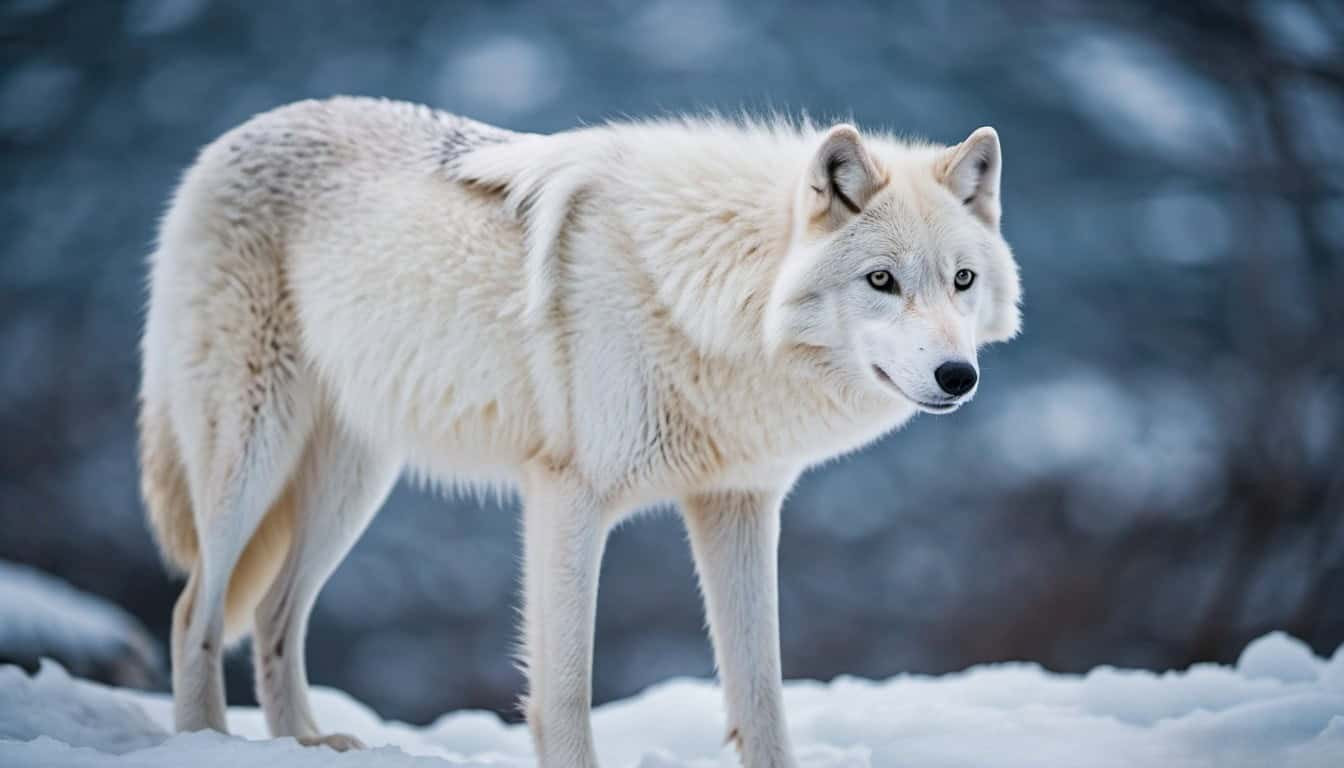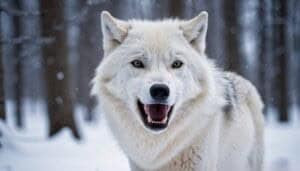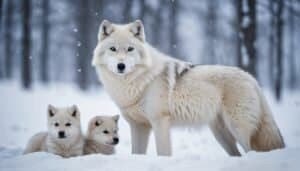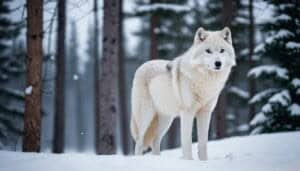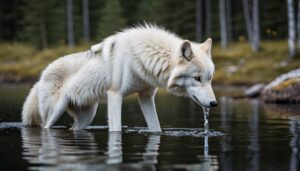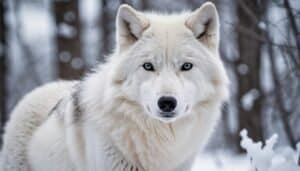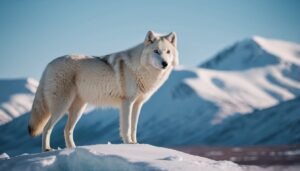Introduction
Arctic wolves, native to the extreme cold of the Arctic regions, have developed remarkable adaptations to survive in harsh climates and prevent frostbite
This article explores the unique characteristics of their fur, blood circulation, behavior, and diet that contribute to their ability to thrive in freezing temperatures. We will delve into scientific studies and genetic factors, examining how these wolves manage to avoid frostbite and what challenges they face in their icy habitats
Adaptations of Arctic Wolves
Arctic wolves have developed a variety of adaptations that allow them to thrive in some of the coldest environments on Earth. These adaptations help them prevent frostbite and maintain their body heat despite the freezing temperatures they face daily
Insulation Properties of Fur
One of the most crucial adaptations of Arctic wolves is their thick, insulating fur
This fur comprises two layers: a dense undercoat and a longer, water-resistant outer coat. The undercoat is soft and traps warm air close to the body, providing excellent insulation against the cold. The outer coat consists of longer, guard hairs that repel water and snow, preventing moisture from reaching the skin
A study published in the journal “Mammalian Biology” (2015) noted that the density of the Arctic wolf’s fur is significantly higher than that of other wolf species, which contributes to its superior insulation properties
The guard hairs are hollow, which adds to their insulating capabilities by trapping air, much like double-glazed windows insulate a house
Comparison with Other Wolf Species
When comparing Arctic wolves to other wolf species, their adaptations become even more apparent. For instance, gray wolves, which inhabit more temperate regions, have shorter and less dense fur
This difference in fur density and length is directly related to the varying climates in which these species live. The Arctic wolf’s fur is not only denser but also has a higher oil content, which helps in shedding water and maintaining dry fur even in snowy conditions
Seasonal Changes in Fur
Another fascinating aspect of Arctic wolves is their seasonal fur changes. During the spring and summer months, Arctic wolves shed their heavy winter coats and develop a lighter, thinner coat more suitable for warmer temperatures
This seasonal shedding helps them avoid overheating while still providing adequate protection against the chill of Arctic summers. The process of shedding and regrowth is meticulously timed with the seasons, ensuring that they are always adequately insulated
A 2018 study in “Journal of Zoology” highlighted that the shedding process is hormonally regulated and triggered by changes in daylight hours rather than temperature alone
This ensures that Arctic wolves are prepared for the seasonal changes in their environment, maintaining their ability to prevent frostbite and overheating
Structure and Composition of Paw Pads
Arctic wolves also have specially adapted paw pads that play a significant role in preventing frostbite. Their paw pads are covered with a thick layer of fur, which provides insulation against the cold ground
Additionally, the pads themselves have a high-fat content, which prevents them from freezing. The combination of fur and fatty pads ensures that Arctic wolves can traverse icy terrain without risking frostbite
Behavioral Adaptations to Protect Paws
Beyond the physical adaptations, Arctic wolves exhibit behaviors that help protect their paws from the cold. They often curl up tightly when resting, covering their paws with their tails to keep them warm
When traveling across ice or snow, they minimize contact with the ground by stepping lightly and frequently shifting their weight. These behaviors, combined with their physical adaptations, significantly reduce the risk of frostbite in their extremities
Arctic wolves’ ability to avoid frostbite through their unique fur characteristics and paw adaptations is a testament to their evolutionary success in one of the most extreme environments on Earth. Their thick, multi-layered fur, specialized paw pads, and behavior all contribute to their remarkable resilience against the cold
Blood Circulation and Heat Conservation
Arctic wolves possess unique adaptations in their blood circulation systems that play a crucial role in preventing frostbite and conserving heat in the extreme cold of the Arctic environment
These physiological traits ensure that their bodies can maintain a stable temperature and effectively manage blood flow to vital areas
Vasoconstriction and Vasodilation
Vasoconstriction and vasodilation are key mechanisms used by Arctic wolves to regulate their body temperature
Vasoconstriction is the narrowing of blood vessels, which reduces blood flow to the skin and extremities. This process helps conserve heat by keeping warm blood closer to the core of the body, thereby reducing heat loss from the surface
In contrast, vasodilation is the widening of blood vessels, which increases blood flow to the skin and extremities when necessary, such as during physical activity or in warmer conditions to prevent overheating
A study published in “Comparative Biochemistry and Physiology” (2017) detailed how Arctic wolves can finely tune these mechanisms to adapt to changing temperatures. When exposed to extreme cold, their bodies prioritize maintaining the temperature of essential organs over the extremities, reducing the risk of frostbite
Heat Conservation Mechanisms
In addition to vasoconstriction and vasodilation, Arctic wolves employ several other heat conservation mechanisms. One such mechanism is countercurrent heat exchange, which is found in their limbs
In this process, warm blood flowing from the body core passes close to cold blood returning from the extremities. The heat from the warm blood transfers to the cooler blood, warming it before it returns to the body’s core. This method ensures that the blood reaching the extremities is cooler, minimizing heat loss, while the blood returning to the core is warmer, preserving the body’s overall temperature
A 2019 research article in “Journal of Experimental Biology” explored how countercurrent heat exchange in Arctic wolves is highly efficient, allowing them to maintain optimal body temperatures even in sub-zero conditions
This adaptation is particularly critical for their survival, as it ensures that their limbs and extremities do not lose excessive heat, which could lead to frostbite
Thermal Insulation of Blood Vessels
The structure of the blood vessels in Arctic wolves also contributes to their ability to prevent frostbite
The blood vessels in their extremities are surrounded by layers of fat and connective tissue that provide additional thermal insulation. This insulation helps retain heat within the vessels, preventing the blood from cooling too quickly as it travels through the limbs
Moreover, Arctic wolves have a high volume of brown adipose tissue (BAT), or brown fat, which is specialized for heat production. Brown fat generates heat through a process known as non-shivering thermogenesis, where fatty acids are oxidized to produce heat without muscle contractions
This heat production helps maintain the warmth of blood circulating through the body, further enhancing the wolf’s ability to prevent frostbite
Behavioral Adaptations for Heat Conservation
Behaviorally, Arctic wolves adopt various strategies to conserve heat
During rest, they often curl up in a tight ball, minimizing exposed surface area and reducing heat loss. By tucking their nose under their tail, they create a small, insulated microenvironment that traps their body heat. This behavior is particularly effective during harsh winter nights when temperatures can plummet drastically
Additionally, Arctic wolves seek shelter from the wind by resting in snow dens or behind natural barriers such as rocks and vegetation
These shelters provide a buffer against the chilling winds and help conserve body heat. By combining these behavioral strategies with their physiological adaptations, Arctic wolves effectively manage their body temperature and reduce the risk of frostbite
Arctic Wolf Behavior
Arctic wolves exhibit a range of behaviors that are crucial for their survival in the frigid Arctic environment. These behaviors help them maintain body heat, protect their extremities from frostbite, and effectively hunt and move through their icy habitat
Hunting and Movement Patterns
One of the primary behaviors that help Arctic wolves prevent frostbite is their efficient hunting and movement patterns. Arctic wolves often hunt in packs, which allows them to take down larger prey such as musk oxen and Arctic hares
Hunting in packs not only increases their chances of a successful kill but also helps conserve energy and body heat. During hunts, the wolves take turns leading and breaking through the snow, reducing the energy expenditure of each individual and minimizing exposure to the cold for extended periods
Arctic wolves also have well-developed strategies for moving across the frozen terrain. They travel in single file, stepping in the tracks of the wolf in front of them to minimize energy use and reduce contact with the cold ground
This behavior, known as “trail following,” helps conserve body heat and prevents frostbite by reducing the time each wolf spends directly on the ice or snow
A study published in “Behavioral Ecology” (2016) observed that Arctic wolves cover vast distances during their hunting expeditions, often traveling up to 30 miles in a single day. This high level of activity generates body heat, which helps prevent frostbite
However, the wolves are also adept at conserving energy by resting frequently between hunts, ensuring they do not overexert themselves in the harsh environment
Social Behaviors for Warmth
Arctic wolves are highly social animals, and their pack dynamics play a significant role in their ability to survive the cold
Social behaviors such as huddling together during rest periods help conserve body heat. By sleeping close to one another, wolves share their body warmth, creating a microenvironment that reduces heat loss. This behavior is especially important during the long, cold Arctic nights
During periods of rest, Arctic wolves often curl up into a ball, with their nose tucked under their tail, as mentioned earlier. This position not only conserves heat but also reduces the exposed surface area of their bodies, minimizing the risk of frostbite. The wolves may also dig shallow depressions in the snow, creating a barrier against the wind and further conserving heat
Communication and Coordination
Effective communication and coordination within the pack are essential for maintaining body heat and preventing frostbite
Arctic wolves use a variety of vocalizations, body language, and scent markings to communicate with each other. These communication methods help them coordinate their movements during hunts and locate each other in the vast Arctic landscape
Pack members also engage in social grooming, which strengthens social bonds and promotes cohesion within the group. This grooming behavior can help remove snow and ice from their fur, preventing cold-related issues and maintaining the insulating properties of their coats
Adaptations to Seasonal Changes
Arctic wolves are highly attuned to the seasonal changes in their environment, and their behaviors adapt accordingly
During the winter months, when temperatures are at their lowest, wolves reduce their activity levels and focus on conserving energy. They remain close to their dens and hunting grounds, minimizing unnecessary movement and exposure to the cold
In contrast, during the brief Arctic summer, Arctic wolves increase their activity levels and take advantage of the milder temperatures to hunt and move more freely. The increased availability of prey during this time allows them to build up fat reserves, which are crucial for insulation and energy during the harsher winter months
A 2020 study in “Polar Biology” highlighted how Arctic wolves’ behavioral adaptations to seasonal changes are essential for their survival. The study found that wolves adjust their hunting strategies and movement patterns based on the availability of prey and the prevailing weather conditions, ensuring they remain efficient and effective in their efforts to prevent frostbite and maintain body heat
Diet, Metabolism, and Environmental Challenges
The diet and metabolism of Arctic wolves, along with the environmental challenges they face, play significant roles in their ability to prevent frostbite and survive in the harsh Arctic climate. These factors contribute to their overall health, energy levels, and capacity to maintain body heat
Nutritional Needs in Cold Climates
Arctic wolves have evolved to thrive on a diet that meets their high energy demands in the cold climate
Their primary prey includes musk oxen, Arctic hares, caribou, and small mammals. The consumption of these animals provides the wolves with essential nutrients, particularly fats and proteins, which are crucial for energy production and insulation
A high-fat diet is particularly important for Arctic wolves because fats have a higher caloric content than proteins or carbohydrates. This allows the wolves to store more energy in the form of body fat, which serves as an insulating layer and an energy reserve during periods of food scarcity
A study published in “Canadian Journal of Zoology” (2017) found that the fat content in the prey of Arctic wolves is significantly higher than that of prey in more temperate regions, underscoring the importance of fat in their diet
Role of Body Fat and Muscle
The accumulation of body fat is a key adaptation that helps Arctic wolves prevent frostbite and maintain body heat
Fat serves as an insulating layer that reduces heat loss from the body. Additionally, it acts as an energy reserve that the wolves can rely on during periods when hunting is difficult, such as during extreme cold or blizzards
Muscle mass also plays a role in heat production. The metabolic activity in muscle tissue generates heat, which helps maintain the wolf’s body temperature. During physical activities like hunting and traveling, the muscle-generated heat helps keep the wolves warm
This metabolic heat production is particularly important during the winter months when temperatures are at their lowest
Factors Contributing to Frostbite Risk
Despite their numerous adaptations, Arctic wolves face several environmental challenges that can increase the risk of frostbite
Extreme cold, high winds, and prolonged exposure to the elements can all pose threats. The Arctic environment is characterized by its harsh and unpredictable weather conditions, which can change rapidly and catch even well-adapted animals off guard
One major factor contributing to frostbite risk is the lack of shelter. While Arctic wolves often use natural shelters like rock outcrops or dense vegetation, these are not always available. In such cases, wolves may have to endure prolonged exposure to the wind and cold, increasing the risk of frostbite, particularly on their extremities such as ears, tails, and paws
Coping Strategies in Extreme Conditions
Arctic wolves employ several strategies to cope with extreme conditions and minimize the risk of frostbite
One such strategy is digging snow dens, which provide shelter from the wind and cold. These dens are typically dug into snowdrifts and can offer significant protection from the elements. Inside these dens, the temperature can be much higher than the outside air, providing a relatively warm refuge for the wolves
Another strategy is altering their activity patterns. During extreme cold snaps or blizzards, Arctic wolves reduce their activity levels and conserve energy by resting in sheltered areas. This behavioral adaptation helps them avoid unnecessary exposure to the cold and reduces the risk of frostbite
Moreover, Arctic wolves are known to be highly adaptive in their social structure. In times of food scarcity or extreme weather, pack dynamics may change to ensure the survival of the group. For instance, pack members might share food more equitably to ensure that all members, including the weaker or younger ones, have enough energy to generate body heat and prevent frostbite
Impact of Climate Change
Climate change poses a new set of challenges for Arctic wolves. Rising temperatures and changing weather patterns can affect the availability of prey and the stability of their habitats
Warmer temperatures might reduce the insulating properties of their fur, and unpredictable weather can lead to more frequent and severe storms, increasing the risk of frostbite and other cold-related issues
A study published in “Global Change Biology” (2019) highlighted the potential impact of climate change on Arctic wolf populations. The study suggested that shifts in prey availability and habitat conditions could force Arctic wolves to adapt their hunting and movement patterns even further, potentially stressing their already finely tuned adaptations to cold environments
Scientific Studies and Findings
Understanding the various adaptations of Arctic wolves to prevent frostbite and survive in their extreme environment has been the focus of numerous scientific studies. These studies offer insights into the genetic, physiological, and behavioral traits that enable these wolves to thrive in the Arctic
Recent Research on Arctic Wolves
Recent research has delved into the genetic and physiological adaptations that allow Arctic wolves to survive and prevent frostbite
One notable study, published in “Nature Communications” (2020), explored the genome of Arctic wolves and identified specific genes associated with cold adaptation. These genes are linked to metabolic processes, fur density, and fat storage, all of which play critical roles in heat conservation and frostbite prevention
The study highlighted that Arctic wolves have a higher expression of genes involved in fat metabolism compared to their temperate counterparts. This genetic adaptation allows them to efficiently convert food into body fat, which serves as both an energy reserve and an insulating layer
Additionally, genes related to fur growth and maintenance were found to be highly active, ensuring that Arctic wolves have the dense, insulating fur necessary for survival in cold climates
Another important study published in “Journal of Experimental Biology” (2021) investigated the thermoregulatory mechanisms in Arctic wolves. The researchers found that these wolves have a highly efficient countercurrent heat exchange system in their limbs, which minimizes heat loss while maintaining necessary blood flow to prevent frostbite
This system is crucial for their ability to navigate the icy terrain without suffering from cold-induced injuries
Genetic Adaptations
The genetic adaptations of Arctic wolves are key to their ability to prevent frostbite
Their genome contains specific adaptations that enhance their cold tolerance. For instance, Arctic wolves have a higher number of mitochondria in their cells compared to other wolf species. Mitochondria are the powerhouses of cells, and their abundance allows for more efficient energy production and heat generation, which is vital in cold environments
A 2019 study in “Genetics” revealed that Arctic wolves possess unique variants of genes associated with the production of antifreeze proteins
These proteins prevent the formation of ice crystals in bodily fluids, which can be a major cause of frostbite. By inhibiting ice crystal formation, these proteins help maintain the integrity of cells and tissues in extremely cold conditions
Furthermore, the study found that Arctic wolves have a robust immune system that can quickly respond to cold stress and potential injuries. This rapid immune response is essential for healing and preventing infections that could arise from frostbite or other cold-related injuries
Comparative Studies with Other Species
Comparative studies between Arctic wolves and other Arctic animals, such as polar bears and Arctic foxes, provide additional insights into the adaptations necessary for survival in extreme cold. These studies highlight both the unique and shared strategies among different species for preventing frostbite
For example, a comparative analysis published in “Polar Research” (2022) showed that, like Arctic wolves, polar bears also have a dense fur coat and a thick layer of body fat for insulation. However, polar bears have additional adaptations such as black skin, which absorbs and retains heat more effectively than the skin of Arctic wolves
In contrast, Arctic foxes exhibit behavioral adaptations that are more similar to those of Arctic wolves, such as digging dens for shelter and curling up to conserve heat. These comparative studies help scientists understand the diverse strategies employed by Arctic animals to cope with extreme cold and prevent frostbite
Implications for Conservation
Understanding the adaptations of Arctic wolves has important implications for conservation efforts
As climate change continues to alter the Arctic environment, the survival of these wolves may be threatened. Conservationists can use insights from genetic and physiological studies to develop strategies that support the resilience of Arctic wolf populations
For instance, preserving critical habitats that provide natural shelters and hunting grounds is essential for maintaining the conditions that allow Arctic wolves to use their behavioral and physiological adaptations effectively. Additionally, monitoring the health and genetic diversity of Arctic wolf populations can help identify potential vulnerabilities and inform targeted conservation actions
A study published in “Conservation Biology” (2023) emphasized the need for adaptive management strategies that consider the impacts of climate change on Arctic ecosystems. By integrating scientific findings on the adaptations of Arctic wolves, conservationists can better predict how these animals might respond to changing conditions and develop proactive measures to ensure their continued survival
Conclusion
In the extreme environment of the Arctic, Arctic wolves have developed a remarkable array of adaptations that enable them to prevent frostbite and survive in frigid temperatures. Their thick, insulating fur, efficient blood circulation and heat conservation mechanisms, and specialized behaviors are all critical to their survival
The high-fat diet and the ability to store energy as body fat provide additional layers of protection and energy reserves, while their hunting and movement patterns minimize exposure to the cold
Scientific research has shed light on the genetic and physiological traits that further enhance these adaptations, revealing the complex interplay between biology and behavior in these resilient animals. Comparative studies with other Arctic species highlight the unique strategies Arctic wolves use, as well as commonalities across different species adapted to cold environments
As climate change continues to impact the Arctic, understanding these adaptations becomes even more crucial for conservation efforts. Protecting the natural habitats and ensuring the genetic diversity of Arctic wolf populations are essential steps in preserving these iconic creatures
Arctic wolves exemplify the extraordinary adaptations required to thrive in one of the harshest climates on Earth. Their ability to prevent frostbite through a combination of physical traits, behaviors, and genetic adaptations underscores the resilience and ingenuity of nature in the face of extreme challenges
